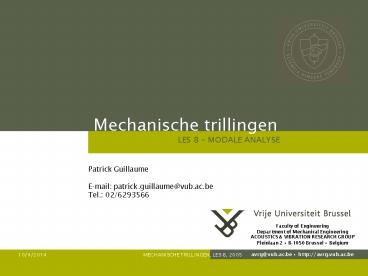Mechanische trillingen - PowerPoint PPT Presentation
Title:
Mechanische trillingen
Description:
Title: Slide 1 Author: Anne Last modified by: Guillaume Created Date: 4/26/2005 6:53:53 AM Document presentation format: On-screen Show Company: ID Other titles – PowerPoint PPT presentation
Number of Views:74
Avg rating:3.0/5.0
Title: Mechanische trillingen
1
Mechanische trillingen
- LES 8 MODALE ANALYSE
Patrick Guillaume E-mail patrick.guillaume_at_vub.
ac.be Tel. 02/6293566
2
Signal vs. System Analysis
- Signal Analysis / Fourier Analysis
- Only the responses (due to the unknown operating
forces) are measured - System Analysis / Modal Analysis
- The system is stimulated with known forces (in
laboratory conditions) - Applied forces and resulting responses are
measured
3
Basic Equations for a 2-DOF System
- Forces acting on mass 1
4
Basic Equations for a 2-DOF System
- Time domain
- Frequency domain (Laplace)
- Matrix notations
- Dynamic stiffness matrix
- Transfer function matrix
5
FRF of 2-DOF System
0
-180
-360
6
Multiple Degree of Freedom (MDOF)
- Dynamic stiffness matrix
- Transfer function matrix
7
FRF and IRF of MDOF Systems
POLES (GLOBAL PARAMETERS)
IMPULSE RESPONSE FUNCTION
FREQUENCY RESPONSE FUNCTION
8
Modal Decomposition
9
Eigenvalues and Eigenvectors
- No Damping
10
Modal Mass and Stiffness
- No Damping
- Modal mass and stiffness are not unique !
11
Modal Coordinates
12
Modal Model
13
Scaling of the Mode Shapes
14
Modal Model Modal Parameters
Modal participation factors
15
Modal Model Modal Parameters
16
Modal Model Modal Parameters
17
Mode Shape Vector
- Mode shape is a deflection-pattern associated
with a modal frequency or pole - Relative displacements
- Mode shapes are continuous functions of position
- Sampled mode shapes mode shape vector
- Spatial resolution and Spatial aliasing
18
Normal and Complex Modes
- Normal modes (or real modes)
- All points are moving in phase or out of phase
- Node points
- Complex modes
- Mode shape vectors are complex
- Node points are not well defined anymore
- Warning Poor measurements
19
Cantilever Beam
20
FRF in respectievelijk knooppunt 1 en 2
Mode 1 2 3
21
Real-Imaginary Plot Peak Picking (normal modes)
22
Simple Structure Mode Shapes
23
Peak Picking
24
Shaker Testing - Fixed FRF Measurements
25
Impact Testing - Roving FRF Measurements
26
Roving or Fixed FRF Measurements
27
Noise in the Output Measurement
- Force measurement
- Electrical noise
- Response measurement
- Electrical noise
- Machines, footsteps, wind, sound, will result
in mechanical noise (process noise) - Least-Squares Estimation
- Minimize the effect of output noise
28
Noise in the Output Measurement Multivariable
29
Noise in the Input Measurement
- At its natural frequencies the structure becomes
very compliant - Least-Squares Estimation
- Minimize the effect of input noise
30
The Coherence Function
- Degree of linearity
- Smaller than 1 when
- Noise in the measurements
- Nonlinearities
31
Noise in the Input and Output Measurements
- Choice of optimal FRF estimator
- H1
- Under estimation
- H2
- Over estimation
- H3, Hv, Hiv,
32
Implementing the Excitation
- Attached exciters
- Electrodynamic exciter
- Hydraulic exciter
- Eccentric rotating masses
- More exotic devices such as rockets,
- Non-attached exciters
- Hammers, impactors
- Acoustic excitation
33
Force Measurements
- Piezo-electric force transducer
- Small size and mass
- Linearity
- Wide dynamic range
- Wide frequency band
- Exciter attachment
- Stringer
- High axial stiffness
- Low transverse and rotational stiffness
- Mechanical fuse
- Protection against destructive overload
34
Random Excitation
- Random sequence with Gaussian distribution
- Random amplitudes and phases
- Averaging is needed
- Converge to flat amplitude spectrum
- Remark Force is not flat in general due to
interaction with the structure - Signal processing errors (leakage errors)
- Effect of nonlinearities is reduced by averaging
35
Random Noise
36
Uniform Window
37
Hanning Window
38
Burst Random
39
Burst Random with Uniform Window
40
Exponential Window
41
Periodic Random / Pseudo-Random Excitation
- Periodic random
- No leakage errors (periodic signal) in
steady-state conditions - Averaging is required
- Pseudo random
- Constant amplitudes and random phases
- No leakage errors (periodic signal) in
steady-state conditions - Averaging is not required
42
Impact Excitation
- Force transducer and tip
- Advantages
- Easy to use
- No interaction with structure
- Force is flat in useful frequency range
- Relatively inexpensive
43
Impact Excitation
- Disadvantages
- Large crest factor
- Nonlinearities
- Limited control of amplitude spectrum
44
Force Window
- Force window (or transient window)
- Remove noise
- Effect of Double Hits
45
Response Window
- Lightly damped structure
- Leakage errors
- Heavily damped structure
- Remove noise

